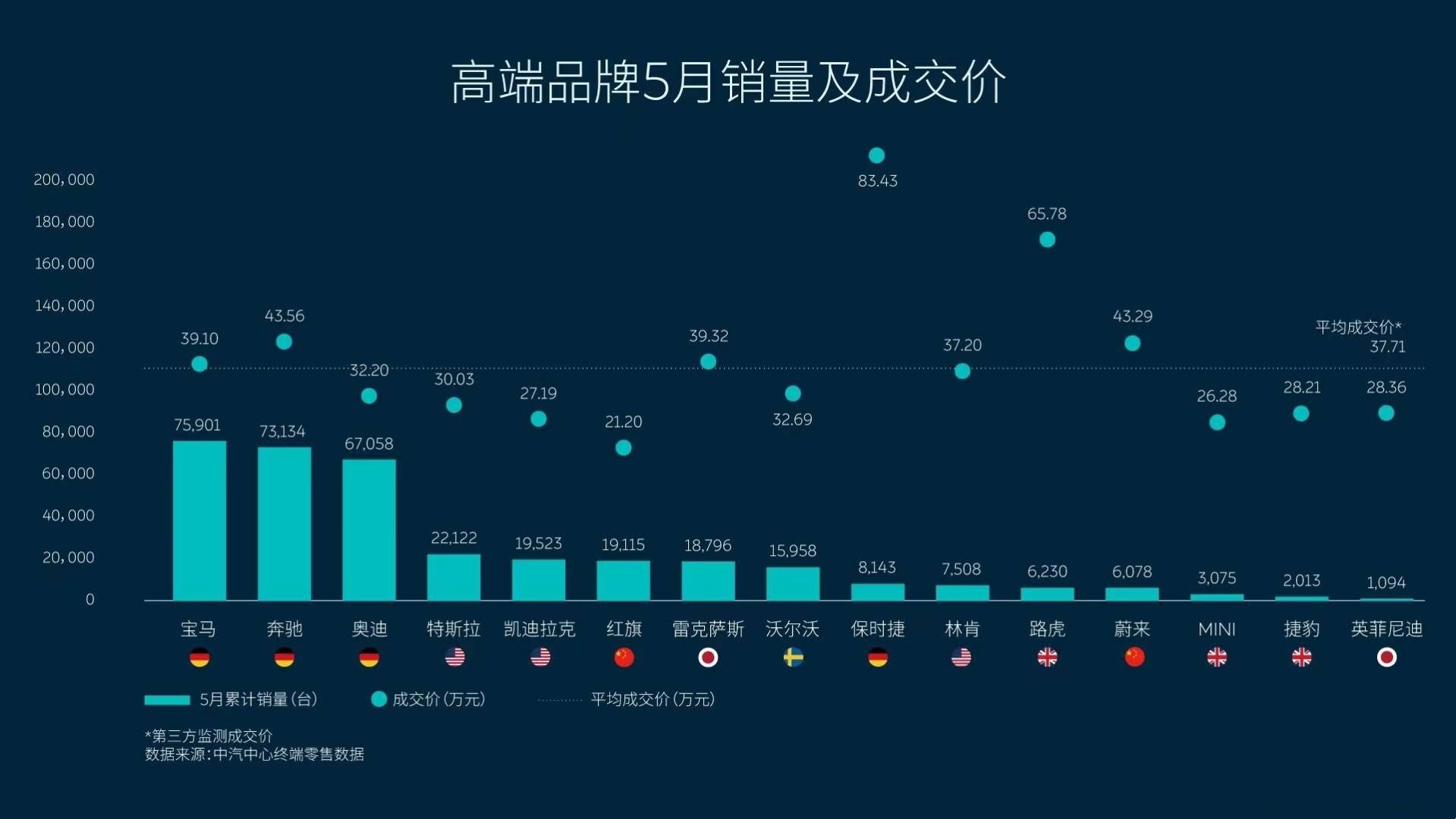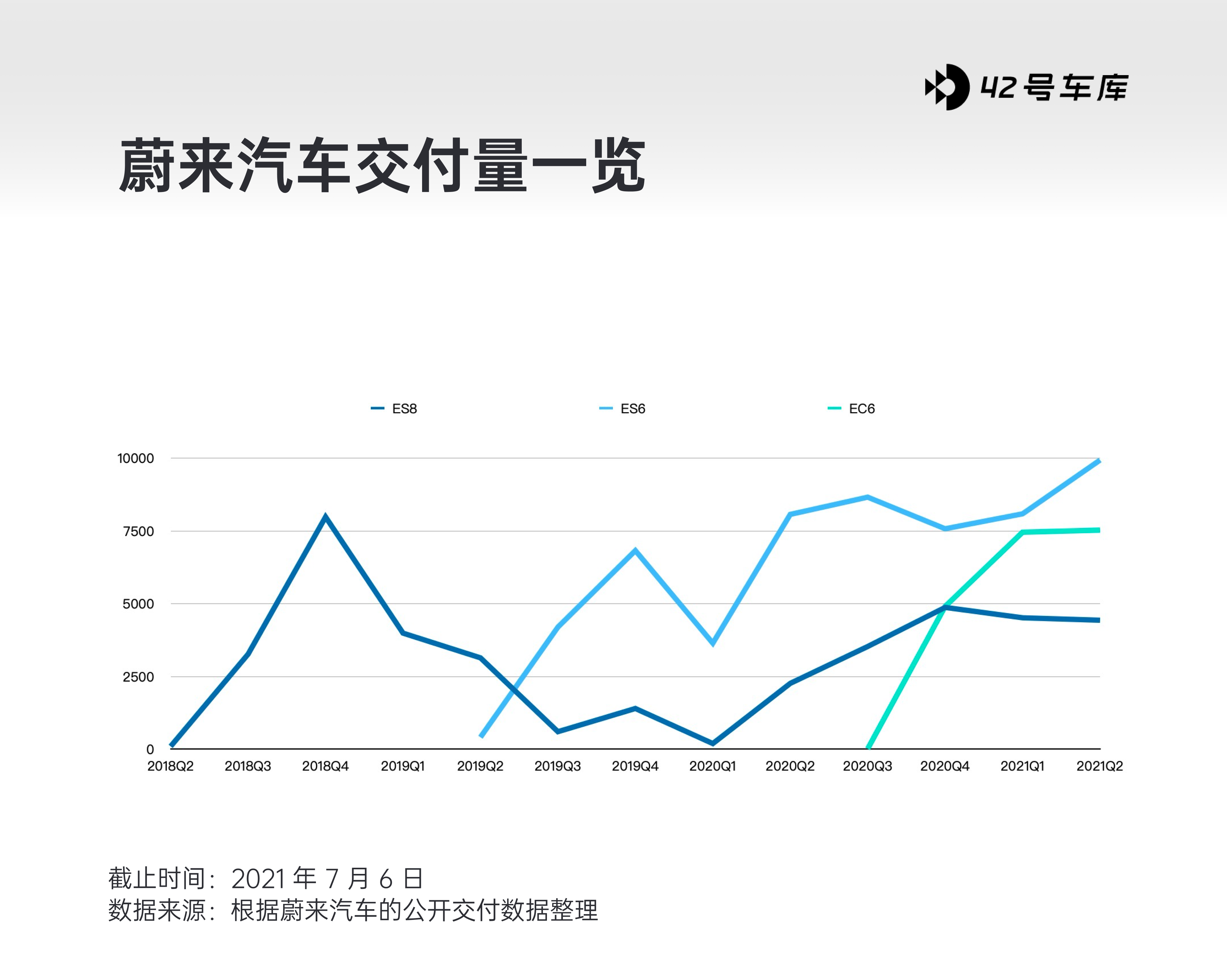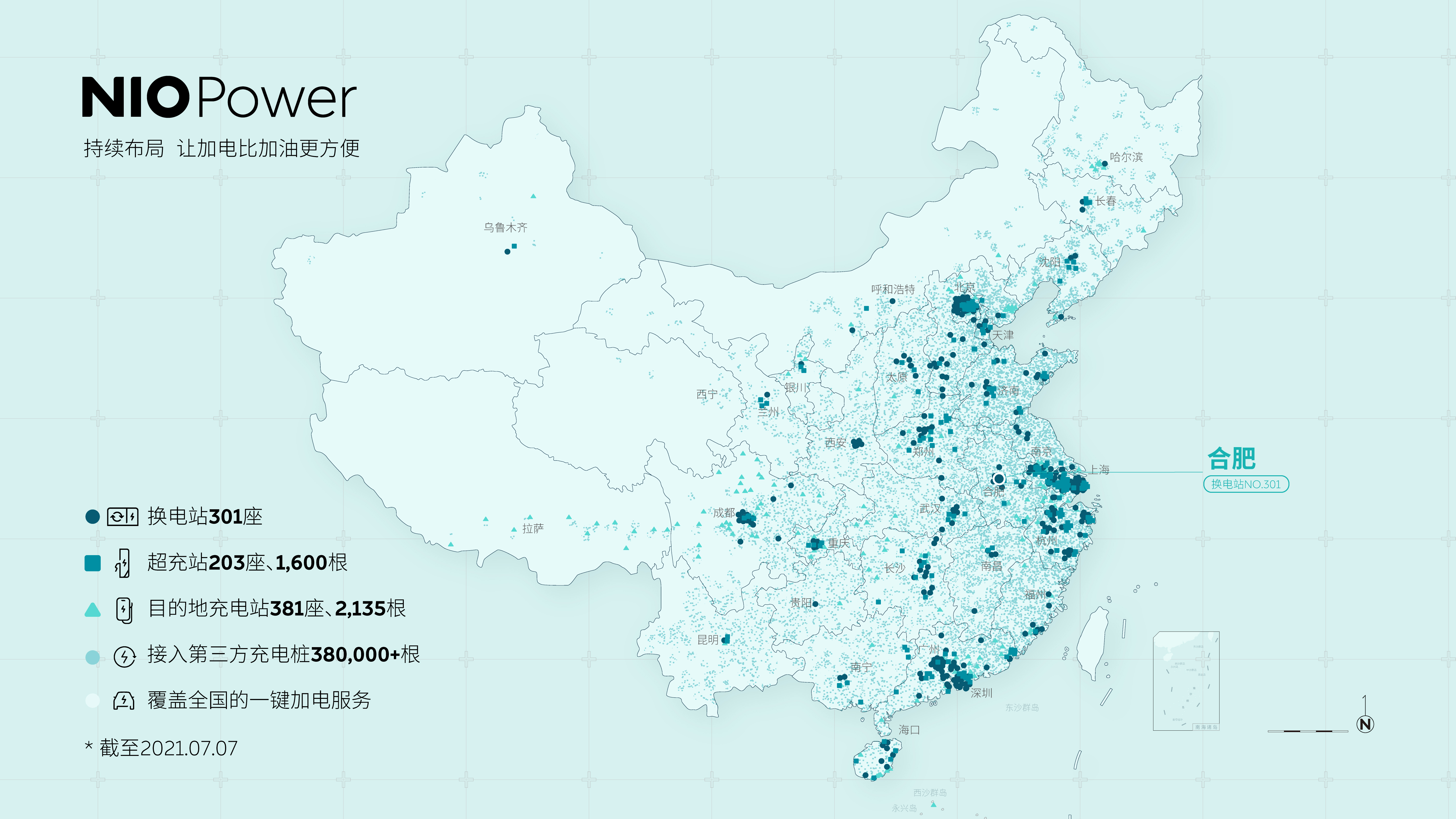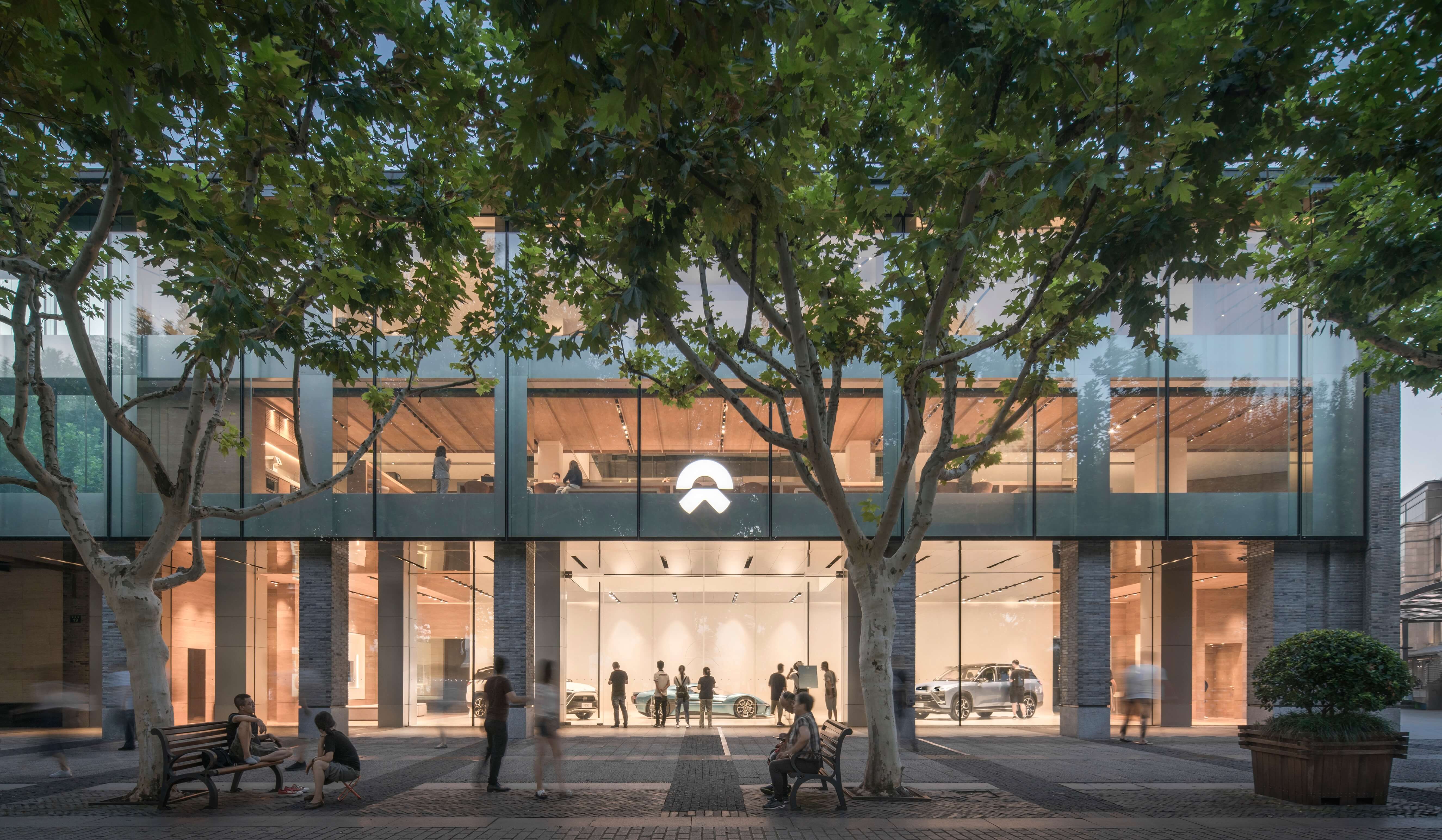No new cars this year, but NIO’s delivery hit a record high
In line with NIO’s rhythm of publishing new models every year on NIO Day, the ES8 was launched in 2017, followed by the ES6 in 2018, the renewed ES8 and debut of the EC6 in 2019. Looking back to NIO Day in January this year, NIO announced the ET7 would be delivered in Q1 of next year. It is reasonable to wonder how the absence of new models will impact NIO’s sales and how NIO will ensure sales growth this year.
As we pass the halfway mark of 2021, despite the cloud of chip shortage, the competition in the EV market has intensified and moved at a faster pace for new entrants. At the beginning of July, NIO, XPeng, and Li Xiang (IDEA) released their delivery numbers for June, handing in the answer sheet for the first half of 2021. NIO was ranked first with a total of 8,083 deliveries (1,498 ES8, 3,755 ES6, and 2,830 EC6), exceeding 8,000 for the first time and a YoY growth of 116.1%.
During the Q1 earnings call this year, William Bin Li, the founder, chairman, and CEO of NIO stated, “Overall demand for our products remains strong, but the supply chain still faces significant challenges due to chip shortage. With the strong momentum in the volatile macro environment, we expect to deliver 21,000 to 22,000 vehicles in the second quarter of 2021.”
As June ended, NIO delivered a total of 21,896 vehicles in Q2, achieving the expectation set in the earnings, and had a YoY growth in the past five quarters. NIO also delivered 41,956 vehicles in the first half of this year, accounting for 95.9% of the total number delivered in 2020. The cumulative delivery of NIO has reached 117,597 vehicles.
Apart from the delivery data, NIO has been catching up to the BBA trio’s average transaction price. Although NIO has yet to release June’s transaction data, the figure for May serves as an example. NIO delivered 6,711 vehicles in May, including 1,412 ES8, 3,017 ES6, and 2,282 EC6. The average transaction price was RMB 432,900, while BMW, Benz, and Audi were RMB 391,000, RMB 435,600, and RMB 322,000, respectively.

Data source: China Automotive Energy Research Institute Terminal Sales Data
Leaving the ICU and Riding the Trend
From the second half of 2020 to now in 2021, the new energy vehicle market has grown against the trend. However, before the new players in the EV market rode the trend, they all struggled to stay afloat.
Leaving the ICU
It is not difficult to see from the graph that the intersection between the ES8 delivery line and the ES6 delivery line, which is during Q2 and Q3 2019, was a difficult period for NIO in the “ICU” phase.
Shortly after the ES8 delivery, a series of negative events concerning battery life and electric batteries caused NIO’s sales to almost halve in 2019. NIO almost did not add any new battery swapping stations that year, and the construction of NIO House was also greatly hindered. On March 22, 2019, Li Bin sent an internal letter titled “The World Doesn’t Owe NIO Anything,” saying, “society does not owe NIO any understanding, we can only prove ourselves through better products and services.”
Later, Li Bin thanked NIO’s users for not giving up on them in an interview. It was because of the car owners’ “never give up” attitude that NIO was able to deliver 8,000 cars in the most difficult Q4 of 2019, bringing valuable cash flow. In Q1 2020, the proportion of orders recommended by NIO’s loyal customers reached 69%.
On the other hand, NIO successfully received “life-saving” funding from the Hefei government, which to some extent reversed public opinion, stabilized confidence, and helped to increase the number of orders. At the same time, the electric vehicle market was also undergoing changes. On November 8, 2019, the Mercedes-Benz EQC was launched with a starting price of RMB 563,800; ten days later, the Audi e-tron was launched with a starting price of RMB 692,800. However, these electric car models launched by traditional car companies like BBA do not have any advantages in terms of battery life compared to new forces.
From May 27, 2018, when NIO’s first ES8 production car was produced, to April 7, 2021, 1,046 days, had seen the production of 100,000 units. In just over 1,000 days, they had gone through a resurrection.
NIO, who has walked out of the “ICU,” is running forward as much as possible. Next, let’s try to arrange the efforts that NIO has made to achieve this top-ranking delivery record in June.
Power-Swapping System
First, there is the inescapable power-swapping system. In Q4 2020 earnings, NIO stated that it plans to deploy 500 battery swapping stations and 600 charging stations nationwide by the end of 2021.With the deployment of the second-generation swap stations, NIO’s energy replenishment system is accelerating its development. On the last day of the first half of 2021, June 30th, NIO launched 11 new swap stations and 10 new supercharging stations, reaching a total of 300 swap stations. As of July 7th, 2021, NIO has deployed 301 swap stations and 203 supercharging stations nationwide. Compared to charging, the convenience of the swap experience is becoming increasingly apparent. The improvement of the charging and swapping infrastructure undoubtedly further alleviates customers’ range anxiety and lays a solid foundation for sales.

NIO House
As an important customer touchpoint in the direct sales system, NIO House is a key platform for NIO to expand its potential customers and strengthen the sense of identity among owners. NIO House is often located in high-end shopping centers and showcases not only cars but also NIO’s brand culture and lifestyle from different angles to connect with customers.
In the Q4 2020 earnings conference call, Wei Feng, CFO of NIO, explained the reasons for increasing NIO House:
“NIO House is an important channel for order conversion, which helps to enhance brand awareness, expand customer touchpoints, and promote sales conversion. At the same time, it has strong brand communication functions. Against the background of rapid growth in sales revenue, we believe that increasing brand communication investment is beneficial for the long-term interests of both the brand and sales. NIO House is also an important place for user systems and community operations, providing activity space for offline connections and brand promotion of users.”
In addition, with rich experience in operating offline networks, NIO has stronger control over site selection, planning, and cost-effectiveness. The investment and operating costs of a single store are much lower than before. A reference number is that the average single-store investment is 40% of the original investment, while rent and operating costs are 50% of the original.
Currently, there are 263 NIO Houses across the country. Continuously expanding, NIO House brings more customer touchpoints to NIO.

The NIO House at West Lake in Hangzhou
Factory Production CapacityThe key to ensuring delivery is to keep up with production capacity. In the fourth quarter 2020 earnings call, NIO reported that it had reached a fully integrated supply chain production capacity of 7,500 vehicles by January of this year. At the same time, JAC has started expanding its factory and plans to achieve a single shift capacity of 150,000 vehicles and a double shift capacity of 300,000 vehicles by the end of this year, in preparation for the production of ET7 and other follow-up products.
In February, NIO signed a strategic cooperation agreement with the government of Hefei to build a world-class industry cluster. At the end of April, the construction of the Xinqiao Intelligent Electric Vehicle Industrial Park, jointly built by the Hefei government and NIO, began. The initial investment in the park is CNY 50 billion, and it is expected to have an annual output value of over CNY 500 billion after completion, with an annual vehicle production capacity of 1 million and a battery production capacity of 100 GWh.
NIO, the Future
Going Global – Norway
On July 7th, NIO’s second-generation battery swap station, supercharging station, and home charging pile were awarded the TÜV Rheinland EU certification and TÜV MARK certification, meaning that these NIO facilities can be sold and operated in all member states of the European Union. On the same day, the first batch of NIO’s battery swap stations and superchargers have been shipped to Norway.
NIO has announced that it will build a comprehensive charging system in Norway. This year, the European version of the charging map and the first four second-generation battery swap stations will be put into operation. In 2022, NIO will also build battery swap stations in five cities in Norway.
At the same time, NIO has recruited a team of 200 advisors in Norway. With only two months left until the opening of the first NIO House in Norway.
Gemini
There have long been rumors that NIO wants to enter the mass market, which is why Gemini has garnered more speculation than the confirmed ET7 based on the NT 2.0 platform.
The following information about Gemini is known:
On May 10th, JAC Motors released a tender notice for the flexible modification of the Gemini model production line’s final assembly chassis and assembly AGV, with an annual production capacity of 60,000 vehicles and a monthly average output of 5,000 vehicles, nearly doubling the sales volume of the ES6/EC6.
On June 6th, Qin Lihong confirmed at the NIO House opening ceremony on Harbin’s Central Street that Gemini is the new car that NIO brand will launch next year. It will still adopt the NIO brand and be positioned in the high-end market.
In the fourth quarter 2020 earnings call, NIO stated that the NIO brand focuses on the high-end market and will not enter the mass market.In the Q1 2021 earnings conference call, Li Bin reiterated that “NIO focuses on market share in the high-end market. Of course, how to enter the mass market is another strategic issue, but we will definitely not use the NIO brand to enter the mass market. This is a confirmed long-term plan.” In addition, Li Bin mentioned at the recent EP Club that all current models will be iterated next year.
Combined with the name “Gemini,” which means “twin stars” – two stars with extremely close masses that attract each other and rotate around each other – although it is not the official name of a model, there must be a meaning behind it. Therefore, Gemini is likely not referring to a single model, but rather represents two different models.
Combining with the bidding announcement released by JAC Motors, the monthly production volume is approximately the total of ES6 and EC6. Therefore, we speculate that the Gemini model is most likely a new version of ES6/EC6.
For this year without any new car release, in order to make the delivery results outstanding, NIO is continuously promoting its energy replenishment system and making efforts in terms of car purchase discounts and financial means, such as introducing policies such as paying 200,000 yuan down payment and paying the balance without interest after one year; NIO Pilot, and various optional discounts.
However, looking at the data, it can be seen that not only one new force achieved record deliveries in June this year, but almost all of them. The first batch of three companies have all achieved record deliveries, and the following companies such as NIO, ZEALER, and Lynk&Co are also keeping up with them.
Next for NIO, on the one hand, it needs to ensure sales without any new car models this year and continue its high-end positioning without wavering. On the other hand, it also needs to explore the domestic mass market and layout in Norway and expand to overseas markets. By standing on the windward side, NIO will continue to maintain its position while also actively seeking to expand in the mass market.
This article is a translation by ChatGPT of a Chinese report from 42HOW. If you have any questions about it, please email bd@42how.com.
